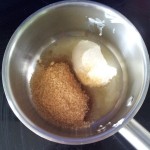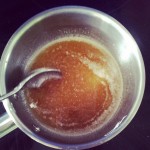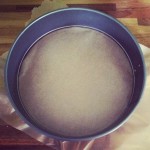 Upside-down cake lends itself easily to infinite variation.
Upside-down cake lends itself easily to infinite variation.
Personally I find it hard to decide which I prefer – fresh peaches with a hint of heady rosewater for a cake that seems to taste of summer itself, or the slightly sharper sweetness of kiwi paired with lemon.
Whichever you choose, this upside-down cake makes a visually-striking centrepiece for a picnic or party.
Ingredients
For the topping
2 tbsps (50g) vegan-friendly margarine (and a little extra for greasing)
2 tbsps (50g) demerara sugar
1 tsp vanilla essence
&
2-3 fresh peaches/nectarines, stones removed and cut into thin segments
OR
3 kiwi fruits, peeled and sliced
For the cake batter:
250g plain flour
3 tsp baking powder
250g caster sugar
75ml vegetable oil
250ml soya milk
2 tsp apple cider vinegar
&
up to 1 tsp rosewater
OR
the zest of one lemon and 1/2 the juice
You will also need
baking parchment and/or a little extra vegan-friendly margarine for greasing
Method
1. Preheat the oven to 180C/Fan 160C. Line the base of a 10” (26 cm)round cake tin with baking paper and grease the sides with a little vegan-friendly margarine. Destone the peaches and cut them into even slices.
2. Put the demerara sugar, margarine and vanilla essence into a small saucepan and heat gently, stirring often, until the margarine has melted and the sugar completely dissolved. Pour this into the base of the prepared cake tin and spread it around. Arrange the fruit slices on top in a single layer, with as few gaps as possible (start by forming a ring around the outside edge, and then work towards the middle).
3. Pour the soya milk into a small bowl, add the vinegar and stir: this will make the milk curdle. Set aside.
4. Sift the flour and baking powder into a large bowl. Add the sugar and stir. Then pour the milk/vinegar mixture, oil and rosewater or lemon zest & juice into the flour and mix until all the flour is combined and you have a smooth cake batter – try not to over-mix it though.
6. Gently spread the cake batter over the fruit slices and bake for about 40 minutes until the cake’s done – it should have shrunk away slightly from the sides of the tin, be firm and springy to the touch, and slightly golden in colour (ovens vary, so set the timer and check on it after 35 minutes, but it might need as long as 45 minutes). Remove from the oven and use a knife to gently loosen the cake from the tin around the edges, and then empty the cake out upside down onto a cooling rack, so that it is then the right way up – i.e. with the fruit on top! Leave to cool.
Notes: Tread carefully with the rosewater, as it’s strong scent means too much can be overpowering – if you’re not a fan, stick with the lemon or substitute vanilla – use your judgment to decide what flavour will work best with the fruit you’re using.
I use a quick-release tin because that’s what I happen to have (I trap the baking paper in the seal to line the base), but this is not essential – a square tin or one with a smaller diameter would work too (you just end up with a smaller, deeper cake), although it may affect the cooking time.
Once the cake has cooled, store it in an airtight container; this cake is best eaten within the first 24 hours.
- 2 tbsps (50g) vegan-friendly margarine (and a little extra for greasing)
- 2 tbsps (50g) demerara sugar
- 1 tsp vanilla essence
- 2-3 fresh peaches/nectarines, stones removed and cut into thin segments
- 3 kiwi fruits, peeled and sliced
- 250g plain flour
- 3 tsp baking powder
- 250g caster sugar
- 75ml vegetable oil
- 250ml soya milk
- 2 tsp apple cider vinegar
- up to 1 tsp rosewater
- the zest of one lemon and ½ the juice
- Preheat the oven to 180C/Fan 160C. Line the base of a 10'' (26 cm)round cake tin with baking paper and grease the sides with a little vegan-friendly margarine. Destone the peaches and cut them into even slices.
- Put the demerara sugar, margarine and vanilla essence into a small saucepan and heat gently, stirring often, until the margarine has melted and the sugar completely dissolved. Pour this into the base of the prepared cake tin and spread it around. Arrange the fruit slices on top in a single layer, with as few gaps as possible (start by forming a ring around the outside edge, and then work towards the middle).
- Pour the soya milk into a small bowl, add the vinegar and stir: this will make the milk curdle. Set aside.
- Sift the flour and baking powder into a large bowl. Add the sugar and stir. Then pour the milk/vinegar mixture, oil and rosewater or lemon zest & juice into the flour and mix until all the flour is combined and you have a smooth cake batter - try not to over-mix it though.
- Gently spread the cake batter over the fruit slices and bake for about 40 minutes until the cake's done - it should have shrunk away slightly from the sides of the tin, be firm and springy to the touch, and slightly golden in colour (ovens vary, so set the timer and check on it after 35 minutes, but it might need as long as 45 minutes). Remove from the oven and use a knife to gently loosen the cake from the tin around the edges, and then empty the cake out upside down onto a cooling rack, so that it is then the right way up - i.e. with the fruit on top! Leave to cool.
I use a quick-release tin because that's what I happen to have (I trap the baking paper in the seal to line the base), but this is not essential - a square tin or one with a smaller diameter would work too (you just end up with a smaller, deeper cake), although it may affect the cooking time.
Once the cake has cooled, store it in an airtight container; this cake is best eaten within the first 24 hours.









